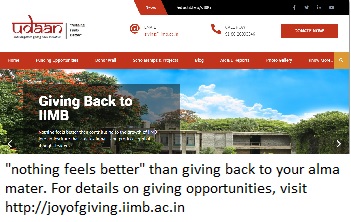Trailblazers: Sanskrit Scholar – Nityanand Misra, PGP 2007
Nityanand Misra heads the Execution Consulting Group at CLSA currently and is based out of Mumbai. He is very passionate about Indian culture, especially classical and medieval Indian literature, classical and folk Indian music, and traditional fine arts and performing arts of India. He has edited and authored seven books so far in Sanskrit, Hindi, and English on Hindu religion, philosophy, and spirituality. His books are very well received by the masses and are revered for the deep knowledge they provide and with the simplicity, they are written.
In an exclusive with the L Square team, Nityanand speaks about when and how he cultivated an interest in the subject, his guru, learnings from the Bhagavad Gita and his latest book.
How did you develop an interest in Sanskrit? What specifically fascinates you about Sanskrit?
A: In my childhood, I was exposed to texts like the Ramacharitamanasa (which is in Awadhi but also has around 50 Sanskrit verses) and the Bhagavad-Gita at home. I then read the Ramayana of Valmiki in the original Sanskrit with a Hindi translation. My interest in Sanskrit started at home with these Hindu scriptures and developed over time. I read Sanskrit at school for eight years, was then out of touch during my engineering days, and came back to it during my student days at IIM Bangalore when I bought S C Vasu’s translation of the Ashtadhyayi of Panini and attended a Samskrita Bharati camp organized by Prof. B Mahadevan of the institute.
With its mellifluous beauty and scientific structure, the ‘devavani’ appeals to both the aesthetically and mathematically inclined. I believe I have a flair for both aesthetics and mathematics, though much more for the latter. Kalidasa’s lively description of the spring in the third canto of the ‘Kumarasambhava’ and Panini’s optimal arrangement of rules in the ‘tripadi’ of the ‘Ashtadhyayi’ are both fascinating, just that Panini fascinates me much more than Kalidasa. Panini’s grammar, rightly called “one of the greatest monuments of human intelligence”, is a mathematician’s delight.
What inspired your interest in the ancient Hindu scriptures?
A: Once again, it was the Bhagavad-Gita. An urge to understand the Bhagavad-Gita better led me to the Upanishads. A famous Sanskrit verse says that all the Upanishads are cows, Krishna is the cowherd, Arjuna is the calf, the wise are the drinkers, and the nectar of Bhagavad-Gita is the great milk. The purport is that the Gita is a summary of the Upanishads. From the Upanishads, going to other Hindu scriptures was only a natural progression. Ancient Hindu scriptures are not just religious or philosophical texts, they are intertwined with many aspects of Hindu culture including literature, music, and art. Anybody interested in the history and culture of India has so much to learn from Hindu scriptures. Much is lost in the translations, so there is nothing like reading Hindu scriptures in the original Sanskrit.
Can you tell us more about your Guru Shri Swami Ramabhadracharya ji.
A: Swami Ramabhadracharya Ji is one of the most prolific Hindu Gurus of the day. He has authored close to 200 books including Sanskrit and Hindi commentaries on the ‘Prasthanatrayi’ (the Upanishads, the Brahma-Sutra, and the Bhagavad-Gita) and the ‘Ashtadhyayi’, and four epic poems (two each in Sanskrit and Hindi). He is both a ‘vaiyakarana’ (expert of Sanskrit Vyakarana) and an ‘ashukavi’ (extempore poet), a rare combination among Sanskrit scholars. He is the founder of a university for the differently-abled in Chitrakoot, Uttar Pradesh, from where around 2,500 differently-abled students have completed graduation, post-graduation, and doctoral studies. He also runs an ‘ashram’ and a small ‘goshala’ in Chitrakoot. Having lost his eyesight at the age of two months and yet achieving so much in life, he is an inspiration to many and a living embodiment of the saying ‘kriyasiddhih sattve bhavati mahataam nopakarane’ (“accomplishment lies in the resolve of the great, not in their means”).
Any two top of the mind learnings from the Upanishads / Bhagavad Gita that is relevant to our modern way of life and help find inner peace.
A: The first is from the Bhagavad-Gita, verse 2.48, where Krishna asks Arjuna to perform actions without attachment and being ‘sama’ (balanced) in success and failure, for such equanimity is Yoga. Success and failure are two sides of the same coin. If the lure of success affects us in some way, the fear of failure will also affect us in some other way. When we overcome both success and failure, we become karmayogis. If you think about it, this is the perfect ‘mantra’ for a start-up, where the chances of failure are more than those of a success. The second is not from an Upanishad but from the ‘Aitareya-brahmana’, verse 33.3, where the four Yugas are compared to four states of humans—asleep, one is Kali-yuga (the age of “strife”); waking up, one is Dvapara-yuga (the age of “doubt” or “uncertainty”); rising from the bed, one is Treta-yuga (the age of “three fires” or energy); and moving, one becomes Krita-Yuga (the age of “accomplishment”). When one thinks of sleep metaphorically as a lack of activity, so many deep meanings come to mind. The journey from strife to doubt to energy to accomplishment is both internal and external, and the mantra inspires us for this beautiful journey with a very powerful and relatable analogy.
The Bhakti movement was reconciled with the Vedas and was given a firm foundation by the Alwars and Sri Ramanujacharya. Have you studied Sri Bhashyam or Divya Prabhandam? Why do you think the Bhakti movement spread across India – a disruptive innovation in social sciences that lasted almost a millennia and continues to appeal to people?
A: I have read parts of the ‘Shri-bhashyam’ in the original Sanskrit. The work along with Ramanuja’s commentary on the Bhagavad-Gita is in my personal library. The ‘Shri-bhashyam’ is a beautiful confluence of ‘bhakti’ (devotion) and ‘jnana’ (knowledge), like the sangam at Prayagraj. I have not had the fortune of reading the ‘Divya-Prabandham’. I hope I get time to learn Tamil one day (when my children have grown up) and read it in Tamil as such works are best read in their original language.
I see the “Bhakti movement” as a gradual development and not “an innovation” or “disruption”. The concept of Bhakti is present in the Shvetashvatara Upanishad and expounded in the Bhagavad Gita, both Sanskrit texts which predate the Alwars and Sri Ramanujacharya. By their works, the Alwars took this bhakti to the masses. Bhakti, as Narada defines in his second Sutra, is supreme love for God. The paths of Karma and Jnana require effort, but the path of Bhakti is much easier as love comes naturally to all humans: we have all experienced love in our lives from our parents, families, and friends. It is this quality of Bhakti, along with its inclusive and egalitarian nature, which made the Bhakti-movement popular across India. In traditional Hinduism, not everybody is an ‘adhikari’ of every spiritual path. For example, ‘upanayana’ and study of Vedas were traditionally restricted to males of ‘trivarna’. This is a distinction in the spiritual journey, though not a discrimination as other paths like study of Ramayana and Puranas were open to all. Bhakti was one such universal path: everybody is an ‘adhikari’ of Bhakti. Ramananda says in ‘Vaishnava-matabja-bhaskara’ (verse 4.50): “All are entitled to prapatti (=surrender).”
Tell us more about your latest book Kumbha – your latest publication? I heard your next book is on Sanskrit names. Do you want to share something about your next book?

A: The book on Kumbha Mela, in both English and Hindi, came out last year when the Ardha Kumbha was held at Prayagraj. In the twelve chapters of the book, I covered not only the sadhus and organization of the Kumbha Mela (to which much literature is dedicated), but also some of the less covered aspects like literature-arts-music, commerce and technology, and diversity and inclusivity. As I had been to three Kumbha Melas earlier, writing this book was also about reliving my experiences which made it special.
My next book is on Sanskrit names for children. A lot of parents these days want to give Sanskrit names to their children but do not have access to Sanskrit pandits or literature. Such parents are misled by name websites, social media, and even books on Sanskrit names by laypersons who are not Sanskrit scholars. They end up giving meaningless names, or worse still, names with ludicrous meanings in Sanskrit. With my book, I wish to not only give them a reliable and referenced source for Sanskrit names but also popularize some rare and/or unused beautiful Sanskrit names like Brihati, Haryaksha, Mayobhav, Vikshar, Yodhika, etc.
We thank Nityanand for his contributions in bringing out the significance of Indian culture so beautifully and for bringing us a step closer in understanding it. We look forward to reading many more of his books in the future.


